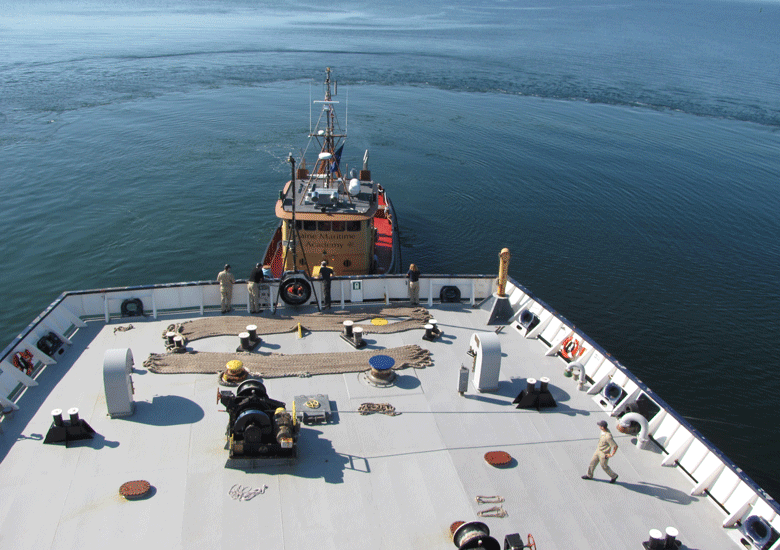Barring the vagaries of pandemics, the economy, and politics, Maine Maritime Academy in Castine will have a new training ship before the end of 2024. Its impacts on both the academy and the town will be hard to miss even before its arrival.
To be christened as the next T/S State of Maine, the new ship is the third of five “national security multi-mission vessels” authorized for construction by Congress. The ships will be owned by the federal Maritime Administration (MARAD), part of the Department of Transportation, and stationed at each of the nation’s state maritime academies to serve both as training ships and as emergency response platforms to be deployed in the event of natural or other disasters.
The new ship will replace the academy’s current training ship, launched by the Navy more than 30 years ago as the oceanographic research vessel USNS Tanner. MARAD began her conversion to the training ship State of Maine in 1996 and delivered the ship to MMA just in time for the school’s 1997 summer cruise.
The huge deckhouse reflects the new ship’s dual mission: training future mariners and delivering emergency relief services…
“This is probably the most exciting time in Maine Maritime Academy’s history,” MMA President Jerry Paul said a few days before heading to a Philadelphia shipyard in mid-July to watch the first steel cut for the new training ship. It’s likely to be exciting for Castine as well.
The current training ship stretches just a few inches less than 500 feet from curved bow to slab-like stern. The new ship, scheduled to arrive in October 2024, will measure 525 feet in length. But that extra 25 feet just hints at how much larger the new ship will be.
With a beam—or width—of 88 feet, 7 inches, the new ship will be nearly 17 feet wider than the old one. The increased beam will be most apparent from the Castine town dock, the waterfront deck at Dennett’s Wharf restaurant, and the Castine Yacht Club, because the ship will likely moor with her bow facing the mouth of the harbor, just the opposite of the current ship. And the new ship is just much bigger.
The current training ship has classroom space and accommodations for up to 302 crew, faculty, and trainees distributed between two box-like structures reaching four stories above the ship’s main deck. Atop the aft house stands a dark blue exhaust funnel emblazoned with MMA’s emblem. The ship’s air draft—it’s greatest height above the water—is 123 feet.
The new ship will have the same air draft, but that doesn’t tell the whole story about how tall, how large, it really will be.
Seated in his shipboard office in June, Capt. Gordon MacArthur, master of MMA’s training ship, said “It’s going to change the whole view-scape of the town,” but “the biggest thing is not the length.”
The current ship has side decks with the deckhouses inset from the ship’s rails. The new ship has one massive deckhouse extending the full beam of the hull and standing, MacArthur said, “20 feet taller” than the deckhouses on the current ship, to about the height of the top of the funnel.
“There will be some shock when the ship pulls in,” he said, “but I think it will die down.”
The huge deckhouse reflects the new ship’s dual mission: training future mariners and delivering emergency relief services when disaster strikes. The ship will have accommodations for up to 1,000 personnel including a mix of crew, faculty, students, and emergency responders, when required, more than three times the capacity of the current State of Maine. The ship will also have state-of-the-art hospital facilities, storage for 60 shipping containers, a helicopter landing pad on deck, and roll-on/roll-off vehicle loading capability via ramps in the hull sides.
Those added capabilities, and the size of the ship itself, will require substantial modifications, possibly replacement, of the pier where the training ship is berthed, and the mooring platforms to which the ship’s lines are attached. The current ship, MacArthur said, uses ten mooring lines. The new ship will require 24.
Before leaving for the Philadelphia shipyard, Paul said it was too soon to know what changes to the pier might entail.
“Each academy will have to adjust its pier,” he said, but “the moorings, the technical aspect of the pier, that’s all up to MARAD.”
MacArthur agreed that the as yet unseen design for the pier—almost certain to be higher to deal with rising sea levels—was MARAD’s responsibility and that it was too soon to predict the scope or timing of construction. The hope, he said, was that the agency would also help finance the multi-million-dollar project.
Whatever the configuration of a new pier, when the ship is in port, the academy will have to deal with its impacts on the town such as more deck lighting and noise from the ship’s ventilation machinery.
Town Manager Shawn Blodgett said the impact on Castine “in a macro sense” was likely to be “minimal,” but that “on the micro level” it was too early to tell. “It’s going to be a localized issue, if it’s an issue at all.”
That’s the hope, MacArthur said.
“We want to be good neighbors. There’s definitely going to be some heartache, but it’s a really good thing for the academy.”





